Abstract
Hot water treatment (HWT) of fruit is an effective approach for managing postharvest decay of fruits and vegetables. In the present study, the effects of HWT (45 °C for 10 min) on the growth of Botrytis cinerea and Penicillium expansum in vitro, and gray (B. cinerea) and blue mold (P. expansum) development in kiwifruit were investigated. HWT effectively inhibited spore germination and germ tube elongation of B. cinerea and P. expansum. Reactive oxygen species accumulation and protein impairment in the fungi triggered by HWT contributed to the inhibitory effect. Results of in vivo studies showed that HWT controlled gray and blue mold in kiwifruit stored at 4 and 25 °C. HWT induced a significant increase in the activity of antioxidant enzymes, including catalase and peroxidase, and the level of total phenolic compounds in kiwifruit. These findings indicate that the inhibition of postharvest decay in kiwifruit by HWT is associated with the inhibition of spore germination of both fungal pathogens and the elicitation of defense response in the kiwifruit host. Moreover, HWT used in this study did not impair fruit quality. HWT appears to represent a potential non-chemical alternative for the effective management of postharvest decay of kiwifruit.




Similar content being viewed by others
References
Alvindia DG, Acda MA (2015) Revisiting the efficacy of hot water treatment in managing anthracnose and stem-end rot diseases of mango cv. ‘Carabao’. Crop Prot 67:96–101
Bai J, Mielke EA, Chen PM, Spotts RA, Serdani M, Hansen JD, Neven L (2006) Effect of high-pressure hot-water washing treatment on fruit quality, insects, and disease in apples and pears: Part I. System description and the effect on fruit quality of ‘d’Anjou’ pears. Postharvest Biol Technol 40:207–215
Bardas GA, Veloukas T, Koutita O, Karaoglanidis GS (2010) Multiple resistance of Botrytis cinerea from kiwifruit to SDHIs, QoIs and fungicides of other chemical groups. Pest Manag Sci 66:967–973
Bautista-Baños S, Long PG, Ganesh S (1997) Curing of kiwifruit for control of postharvest infection by Botrytis cinerea. Postharvest Biol Technol 12:137–145
Bradford MM (1976) A rapid and sensitive method for the quantitation of microgram quantities of protein utilizing the principle of protein-dye binding. Anal Biochem 72:248–254
Cheah LH, de Silva N, Irving DE, Hunt AW, Tate KG (1992) Hot water dips for control of Botrytis storage rot in kiwifruit. Acta Hort 297:605–610
Fallik E (2004) Prestorage hot water treatments (immersion, rinsing and brushing). Postharvest Biol Technol 32:125–134
Fallik E, Tuvia-Alkalai S, Feng X, Lurie S (2001) Ripening characterisation and decay development of stored apples after a short pre-storage hot water rinsing and brushing. Innov Food Sci Emerg 2:127–132
Fatemi H, Mohammadi S, Aminifard MH (2013) Effect of postharvest salicylic acid treatment on fungal decay and some postharvest quality factors of kiwi fruit. Arch Phytopathol Plant Protect 46:1338–1345
Gabler FM, Mansour MF, Smilanick JL, Mackey BE (2004) Survival of spores of Rhizopus stolonifer, Aspergillus niger, Botrytis cinerea and Alternaria alternata after exposure to ethanol solutions at various temperatures. J Appl Microbiol 96:1354–1360
González-Aguilar GA, Gayosso L, Cruz R, Fortiz J, Báez R, Wang CY (2000) Polyamines induced by hot water treatments reduce chilling injury and decay in pepper fruit. Postharvest Biol Technol 18:19–26
Gonzalez-Aguilar GA, Villa-Rodriguez JA, Ayala-Zavala JF, Yahia EM (2010) Improvement of the antioxidant status of tropical fruits as a secondary response to some postharvest treatments. Trends Food Sci Technol 21:475–482
Hong P, Hao W, Luo J, Chen S, Hu M, Zhong G (2014) Combination of hot water, Bacillus amyloliquefaciens HF-01 and sodium bicarbonate treatments to control postharvest decay of mandarin fruit. Postharvest Biol Technol 88:96–102
Hur JS, Oh SO, Lim KM, Jung JS, Kim JW, Koh YJ (2005) Novel effects of TiO2 photocatalytic ozonation on control of postharvest fungal spoilage of kiwifruit. Postharvest Biol Technol 35:109–113
Jemric T, Ivic D, Fruk G, Matijas HS, Cvjetkovic B, Bupic M, Pavkovic B (2011) Reduction of postharvest decay of peach and nectarine caused by Monilinia laxa using hot water dipping. Food Bioprocess Technol 4:149–154
Kamdee C, Ketsa S, van Doorn WG (2009) Effect of heat treatment on ripening and early peel spotting in cv. Sucrier banana. Postharvest Biol Technol 52:288–293
Khademi O, Salvador A, Zamani Z, Besada C (2013) Effects of hot water treatments on antioxidant enzymatic system in reducing flesh browning of persimmon. Food Bioprocess Technol 6:3038–3046
Kim Y, Brecht JK, Talcott ST (2007) Antioxidant phytochemical and fruit quality changes in mango (Mangifera indica L.) following hot water immersion and controlled atmosphere storage. Food Chem 105:1327–1334
Koh YJ, Hur JS, Jung JS (2005) Postharvest fruit rots of kiwifruit (Actinidia deliciosa) in Korea. New Zealand J Crop Hortic Sci 33:303–310
Li B, Lai T, Qin G, Tian S (2010) Ambient pH stress inhibits spore germination of Penicillium expansum by impairing protein synthesis and folding: a proteomic-based study. J Proteome Res 9:298–307
Liu J, Tian S, Meng X, Xu Y (2007) Effects of chitosan on control of postharvest diseases and physiological responses of tomato fruit. Postharvest Biol Technol 44:300–306
Liu J, Sui Y, Wisniewski M, Droby S, Tian S, Norelli J, Hershkovitz V (2012) Effect of heat treatment on inhibition of Monilinia fructicola and induction of disease resistance in peach fruit. Postharvest Biol Technol 65:61–68
Ma Q, Suo J, Huber DJ, Dong X, Han Y, Zhang Z, Rao J (2014) Effect of hot water treatments on chilling injury and expression of a new C-repeat binding factor (CBF) in ‘Hongyang’ kiwifruit during low temperature storage. Postharvest Biol Technol 97:102–110
Maxin P, Huyskens-Keil S, Klopp K, Ebert G (2005) Control of postharvest decay in organic grown apples by hot water treatment. Acta Hot 682:2153–2158
Maxin P, Weber RWS, Pedersen HL, Williams M (2012a) Control of a wide range of storage rots in naturally infected apples by hot-water dipping and rinsing. Postharvest Biol Technol 70:25–31
Maxin P, Weber RWS, Pedersen HL, Williams M (2012b) Hot-water dipping of apples to control Penicillium expansum, Neonectria galligena and Botrytis cinerea: effects of temperature on spore germination and fruit rots. Eur J Hortic Sci 77:S1–9
Michailides TJ, Elmer PAG (2000) Botrytis gray mold of kiwifruit caused by Botrytis cinerea in the United States and New Zealand. Plant Dis 84:208–223
Moscetti R, Carletti L, Monarca D, Cecchini M, Stella E, Massantini R (2013) Effect of alternative postharvest control treatments on the storability of ‘Golden Delicious’ apples. J Sci Food Agric 93:2691–2697
Nafussi B, Ben-Yehoshua S, Rodov V, Peretz J, Ozer BK, D'hallewin G (2001) Mode of action of hot-water dip in reducing decay of lemon fruit. J Agric Food Chem 49:107–113
Neri F, Donati I, Veronesi F, Mazzoni D, Mari M (2010) Evaluation of Penicillium expansum isolates for aggressiveness, growth and patulin accumulation in usual and less common fruit hosts. Int J Food Microbiol 143:109–117
Nesher I, Minz A, Kokkelink L, Tudzynski P, Sharon A (2011) Regulation of pathogenic spore germination by CgRac1 in the fungal plant pathogen Colletotrichum gloeosporioides. Eukaryot Cell 10:1122–1130
Palou L, Smilanick JL, Droby S (2008) Alternatives to conventional fungicides for the control of citrus postharvest green and blue moulds. Stewart Postharvest Rev 4:1–16
Pavoncello D, Lurie S, Droby S, Porat R (2001) A hot water treatment induces resistance to Penicillium digitatum and promotes the accumulation of heat shock and pathogenesis-related proteins in grapefruit flavedo. Physiol Plantarum 111:17–22
Porat R, Daus A, Weiss B, Cohen L, Fallik E, Droby S (2000) Reduction of postharvest decay in organic citrus fruit by a short hot water brushing treatment. Postharvest Biol Technol 18:151–157
Ramos B, González-Melendi P, Sánchez-Vallet A, Sánchez-Rodríguez C, López G, Molina A (2013) Functional genomics tools to decipher the pathogenicity mechanisms of the necrotrophic fungus Plectosphaerella cucumerina in Arabidopsis thaliana. Mol Plant Pathol 14:44–57
Ruiz-García Y, Gómez-Plaza E (2013) Elicitors: a tool for improving fruit phenolic content. Agriculture 3:33–52
Sala JM, Lafuente MT (2000) Catalase enzyme activity is related to tolerance of mandarin fruits to chilling. Postharvest Biol Technol 20:81–89
Schirra M, D’hallewin G, Ben-Yehoshua S, Fallik E (2000) Host-pathogen interactions modulated by heat treatment. Postharvest Biol Technol 21:71–85
Shahkoomahally S, Ramezanian A (2015) Hot water combined with calcium treatment improves physical and physicochemical attributes of kiwifruit (Actinidia deliciosa cv. Hayward) during storage. HortSci 50:412–415
Spadoni A, Neri F, Bertolini P, Mari M (2013) Control of Monilinia rots on fruit naturally infected by hot water treatment in commercial trials. Postharvest Biol Technol 86:280–284
Spadoni A, Guidarelli M, Sanzani SM, Ippolito A, Mari M (2014) Influence of hot water treatment on brown rot of peach and rapid fruit response to heat stress. Postharvest Biol Technol 94:66–73
Spotts RA, Serdani M, Mielke EA, Bai J, Chen PM, Hansen JD, Sanderson PG (2006) Effect of high-pressure hot water washing treatment on fruit quality, insects, and disease in apples and pears: part II. Effect on postharvest decay of d’Anjou pear fruit. Postharvest Biol Technol 40:216–220
Sui Y, Droby S, Zhang D, Wang W, Liu Y (2014) Reduction of Fusarium rot and maintenance of fruit quality in melon using eco-friendly hot water treatment. Environ Sci Pollut Res 21:13956–13963
Villa-Rojas R, López-Malo A, Sosa-Morales ME (2011) Hot water bath treatments assisted by microwave energy to delay postharvest ripening and decay in strawberries (Fragaria × ananassa). J Sci Food Agric 91:2265–2270
Wang C, Buta JG (2003) Maintaining quality of fresh-cut kiwifruit with volatile compounds. Postharvest Biol Technol 28:181–186
Wang K, Cao S, Jin P, Rui H, Zheng Y (2010a) Effect of hot air treatment on postharvest mould decay in Chinese bayberry fruit and the possible mechanisms. Int J Food Microbiol 141:11–16
Wang K, Jin P, Shang H, Li H, Xu F, Hu Q, Zheng Y (2010b) A combination of hot air treatment and nano-packing reduces fruit decay and maintains quality in postharvest Chinese bayberries. J Sci Food Agric 90:2427–2432
Wiilliamson B, Tudzynski B, Tudzynski P, van Kan JA (2007) Botrytis cinerea: the cause of grey mould disease. Mol Plant Pathol 8:561–580
Wurms KV, Long PG, Sharrock KR, Greenwood DR (1999) The potential for resistance to Botrytis cinerea by kiwifruit. Crop Prot 18:427–435
Xu X, Tian S (2008a) Salicylic acid alleviated pathogen-induced oxidative stress in harvested sweet cherry fruit. Postharvest Biol Technol 49:379–385
Xu XB, Tian SP (2008b) Reducing oxidative stress in sweet cherry fruit by Pichia membranaefaciens: a possible mode of action against Penicillium expansum. J Appl Microbiol 105:1170–1177
Yang Q, Rao J, Yi S, Meng K, Wu J, Hou Y (2012) Antioxidant enzyme activity and chilling injury during low-temperature storage of kiwifruit cv. Hongyang exposed to gradual postharvest cooling. Hort Environ Biotechnol 53:505–512
Yuan L, Bi Y, Ge Y, Wang Y, Liu Y, Li G (2013) Postharvest hot water dipping reduces decay by inducing disease resistance and maintaining firmness in muskmelon (Cucumis melo L.). Sci Hortic 161:101–110
Zhang H, Wang S, Huang X, Dong Y, Zheng X (2008) Integrated control of postharvest blue mold decay of pears with hot water treatment and Rhodotorula glutinis. Postharvest Biol Technol 49:308–313
Zhao W, Wisniewski M, Wang W, Liu J, Liu Y (2014) Heat-induced oxidative injury contributes to inhibition of Botrytis cinerea spore germination and growth. World J Microbiol Biotechnol 30:951–957
Acknowledgments
This work was supported by a Project from Department of Education, Anhui Province (No. KJ2014ZD25), a Project from National Natural Science Foundation of China (No. 31471157), and a Collaborative Project between Hefei University of Technology and USDA (No. 58-1931-4-008FN).
Compliance with ethical standards
The authors declare that they have no conflict of interest. This article does not contain any studies with human participants or animals.
Author information
Authors and Affiliations
Corresponding author
Additional information
Responsible editor: Philippe Garrigues
Rights and permissions
About this article
Cite this article
Chen, H., Cheng, Z., Wisniewski, M. et al. Ecofriendly hot water treatment reduces postharvest decay and elicits defense response in kiwifruit. Environ Sci Pollut Res 22, 15037–15045 (2015). https://doi.org/10.1007/s11356-015-4714-1
Received:
Accepted:
Published:
Issue Date:
DOI: https://doi.org/10.1007/s11356-015-4714-1




